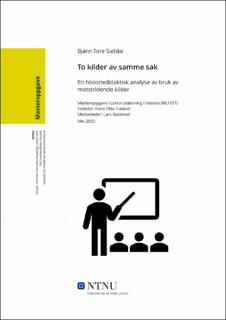| dc.description.abstract | Denne oppgaven er en sammensatt oppgave som undersøker hvordan, og hvorfor man burde og kan benytte seg av motstridende kilder i historieundervisning i relasjon til den nye læreplanen, kunnskapsløftet 2020. Dette sees spesielt opp mot tilegnelsen av kildekritisk kompetanse og nærliggende ferdigheter. Dette gjøres i tre deler. Første del er en historiedidaktisk diskusjon av bruken av motstridende kilder opp mot læreplanen og undervisningsstrategier som kan benyttes. Annen del består er realhistorisk og undersøker om en hendelse kan regnes som en likvidasjon, og diskuterer forskjellene mellom de historiske framstillinger som benytte i undervisningen. Tredje del er sentrert rundt en serie intervju som undersøker elevens opplevde læringsutbytte av en undervisning som tar i bruk undervisningsstrategiene med et utgangspunkt i det realhistoriske materialet.
Den historiedidaktiske diskusjonen argumenterer for at læreplanen har gjort det klart at kildekritisk kompetanse og historiefaglige ferdigheter skal ha en sentral plass i historiefaget. Med utgangspunkt i læreplanens adopsjon av et funksjonelt kildebegrep vil det være fordelaktig å benytte motstridende kilder. For kunne gjøre dette i skolen introduseres en undervisningsmodell der de ulike hjelpemidler diskuteres og presenteres. Disse viser hvordan man kan undervise med utgangspunkt med motstridende kilder samtidig som viktigheten av valget av materialet diskuteres med utgangspunkt i Klafkis kategoriale danning. Deretter presenteres og diskuteres det realhistoriske materialet. Forskjellene i utvalget for den realhistoriske fremstillingen og undervisningen blir eksemplifisert. Det realhistoriske materialet knyttes opp mot hva det er ønskelig at det skal eksemplifisere og viser hvordan utvalget av material har en betydelig rolle for hvordan det kan brukes til å skape forståelse og refleksjoner blant elevene.
Avslutningsvis er elevperspektivet undersøkt. Elevene opplevde at motstridende kilder var forsterkende og at de tilegnet seg en kildekritisk metode. Eleven tilegnet seg historisk empati og flere tolkningsperspektiv, men de slet med å vise dette utover den aktuelle situasjonen og å se seg selv som tolkende. De viste likevel gjennom intervjuet at refleksjonene de gjorde seg og forståelsen modnet noe etter hvert. Elevene opplevde at metodene de lærte som relevante og forstilte seg flere situasjoner hvor de kunne bruke kunnskapen de hadde tilegnet seg i dagliglivet og i skolen utenfor historiefaget. Undersøkelsen skjedde ikke etter en optimal metode, men ga tydelige indikasjoner på at motstridende kilder kan ha svært positive effekter i klasserommet. | |
| dc.description.abstract | This compound thesis researches how, and why you should use contradicting sources in history according to the new curriculum, Kunnskapsløftet 2020. This is seen in relation to the acquisition of the competence to critically evaluate and study historical sources and related skills. This thesis consists of three parts. The first part is a history didactic discussion examining the use of contradicting sources in relation to the curriculum and teaching strategies. The second part investigates a possible liquidation and discusses the difference between using the sources for teaching practices and academic writing. The last part is centred around interviews with students in the last year of high school and discuss which skills or knowledge the students experience themselves to have acquired as a result of teaching methods using contradicting sources.
The history didactic discussion argues that the new curriculum has made it clearer that the competence to critically evaluate and study sources and other related skills should have a prominent place in history education. The use of contradicting sources appears to be a strength with the adaption of a functional understanding of sources. The thesis introduces a teaching method, where different aids are introduced and discussed in relation to the implementation of contradicting sources. The teaching aids and method shows how to teach with contradicting sources, while also discussing the importance of choosing and using historical material. The method used for choosing materials is closely linked to Klafkis categorial Bildung. Because of the importance of the material, it is presented in the second part of the thesis where it is used in a discussion regarding wherever a selected event can be viewed as a liquidation. After the discussion the selection and usage of sources is discussed, and it is exemplified how material can be used to show students the importance of these skills in history.
Lastly the student perspective was researched. The students experienced that contradicting sources strengthened their understanding of how to evaluate and use historical sources. The students appeared to acquire different ways of interpreting the sources, but hey showed a lack of ability to differentiate their own views from the views of historical persons, and in seeing themself as interpreters. However, trough the interviews the students showed that they were able to come to a greater understanding of the subject upon further reflection. The students also acknowledged the potential usefulness of the skills they ha acquired in their everyday life. Even though the method was not optimal, the interview showed that using contradicting sources could have positive effects. | |
